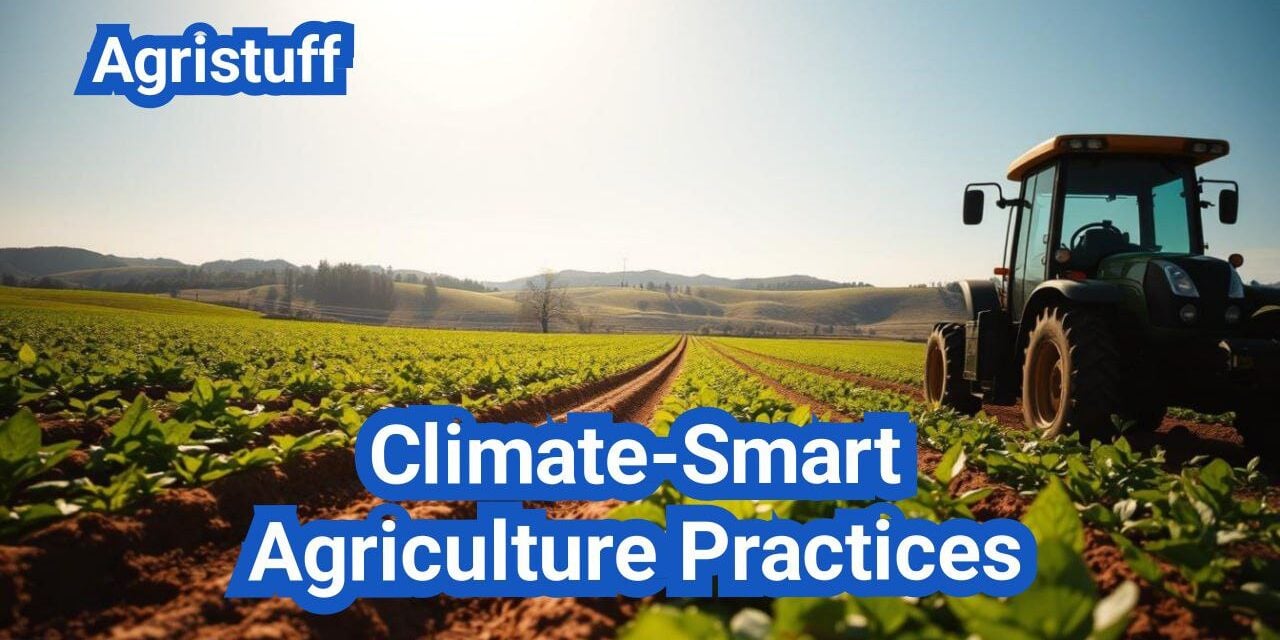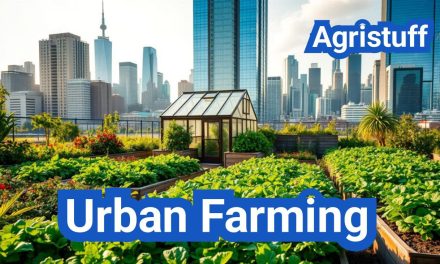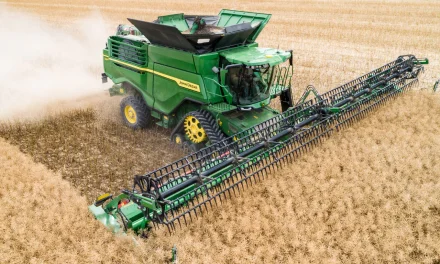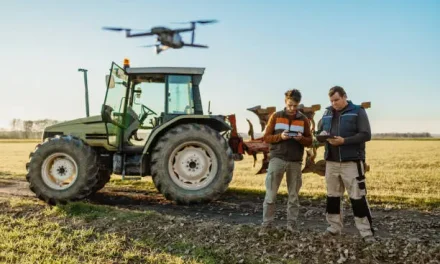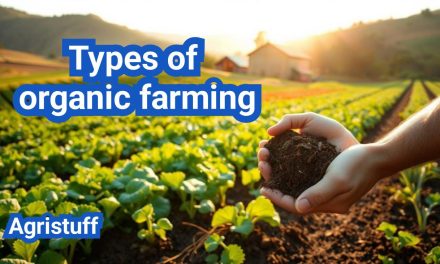Climate-smart agriculture (CSA) is a vital approach in addressing the pressing issue of climate change. It encompasses a range of agricultural practices and technologies designed to boost productivity, enhance resilience, and reduce greenhouse gas emissions.
By adopting CSA, farmers and agricultural communities can play a crucial role in climate change mitigation while ensuring food security and sustainable livelihoods.
The importance of Climate-Smart Agriculture Practices lies in its ability to integrate multiple benefits, making it a practical and effective strategy for a more sustainable agricultural future.
Key Takeaways
- CSA enhances agricultural productivity and resilience.
- It reduces greenhouse gas emissions through sustainable practices.
- CSA is crucial for climate change mitigation efforts.
- Adopting CSA ensures food security and sustainable livelihoods.
- It integrates multiple benefits for a sustainable agricultural future.
Understanding Climate-Smart Agriculture
As the world grapples with the challenges of climate change, Climate-Smart Agriculture (CSA) emerges as a critical strategy. CSA is an approach that aims to promote agricultural practices that not only improve productivity but also enhance resilience and reduce greenhouse gas emissions.
The concept of CSA is built around three core pillars: increasing productivity, enhancing resilience, and reducing emissions. These pillars are interconnected and form the foundation of CSA practices.
The Three Pillars of Climate-Smart Agriculture
The first pillar, increasing productivity, focuses on improving agricultural yields and ensuring food security. This involves adopting practices such as using high-quality seeds, implementing efficient irrigation systems, and integrating crop and animal management.
The second pillar, enhancing resilience, is about building the capacity of agricultural systems to withstand the impacts of climate change. This includes practices like agroforestry, conservation agriculture, and improving soil health.
The third pillar, reducing emissions, aims at minimizing the carbon footprint of agricultural activities. Techniques such as using renewable energy, reducing synthetic fertilizer use, and implementing manure management systems are crucial here.
| Pillar | Objective | Example Practices |
|---|---|---|
| Increasing Productivity | Improve agricultural yields and food security | High-quality seeds, efficient irrigation |
| Enhancing Resilience | Build capacity to withstand climate impacts | Agroforestry, conservation agriculture |
| Reducing Emissions | Minimize carbon footprint | Renewable energy, reduced synthetic fertilizer |
Why Climate-Smart Agriculture Matters
CSA matters because it addresses the pressing issue of climate change, which poses significant threats to agricultural productivity and food security. By adopting CSA practices, farmers can not only reduce their environmental impact but also improve their resilience to climate-related shocks.
“Climate-Smart Agriculture is not just about reducing emissions; it’s about building a more resilient food system that can withstand the challenges of climate change.”
— FAO Statement on Climate-Smart Agriculture
Implementing CSA requires a holistic approach that considers the local context, including climate, soil type, and socio-economic factors. By understanding and applying the principles of CSA, farmers and policymakers can work together to create a more sustainable agricultural sector.
The Science Behind Agricultural Emissions

Understanding the science behind agricultural emissions is crucial for developing effective strategies to reduce the carbon footprint of farming practices. Agricultural activities are significant contributors to global greenhouse gas emissions, primarily due to the release of nitrous oxide (N2O), methane (CH4), and carbon dioxide (CO2).
Major Sources of Greenhouse Gases in Agriculture
Agricultural emissions arise from various sources, including:
- Livestock: Enteric fermentation in ruminant animals like cattle and sheep produces methane.
- Fertilizers: The use of nitrogen-based fertilizers leads to the release of nitrous oxide.
- Soil Management: Tillage practices can affect soil carbon storage, leading to CO2 emissions.
- Manure Management: The handling and storage of manure can result in methane and nitrous oxide emissions.
The table below summarizes the primary greenhouse gases emitted by agricultural activities and their sources.
| Greenhouse Gas | Agricultural Source |
|---|---|
| Methane (CH4) | Livestock enteric fermentation, manure management |
| Nitrous Oxide (N2O) | Nitrogen-based fertilizers, manure management |
| Carbon Dioxide (CO2) | Soil tillage, machinery use |
Measuring Agricultural Carbon Footprint
Measuring the carbon footprint of agricultural activities involves assessing the emissions from various practices and sources. This can be achieved through:
- Life Cycle Assessment (LCA): Evaluating the environmental impacts of agricultural products throughout their entire lifecycle.
- Carbon Calculators: Tools that estimate greenhouse gas emissions based on farm-specific data.
- Field Measurements: Direct measurement of emissions using techniques like eddy covariance.
By understanding the sources of agricultural emissions and employing accurate measurement techniques, farmers and policymakers can develop targeted strategies to mitigate climate change.
Soil Carbon Sequestration Techniques
Enhancing soil carbon sequestration is essential for reducing atmospheric CO2 levels and promoting sustainable agriculture. Soil carbon sequestration refers to the process of transferring carbon from the atmosphere into the soil through various agricultural practices.
Building Soil Organic Matter
One effective method for enhancing soil carbon sequestration is by building soil organic matter. Practices such as conservation tillage and cover cropping can significantly increase soil organic carbon. Conservation tillage reduces soil disturbance, thereby minimizing the release of stored carbon into the atmosphere. Cover crops, on the other hand, add organic matter to the soil through their roots and biomass.
“By adopting conservation tillage and cover cropping, farmers can not only improve soil health but also contribute to climate change mitigation,” says a recent study on agricultural carbon sequestration.
Biochar and Other Carbon-Rich Amendments
Another technique involves the use of biochar and other carbon-rich amendments. Biochar, produced through the pyrolysis of organic materials, is highly stable and can persist in soils for centuries, enhancing long-term carbon sequestration. Other amendments, such as manure and compost, also contribute to soil carbon storage.
- Biochar application can improve soil fertility and structure.
- Manure and compost add nutrients and organic matter to the soil.
Monitoring Soil Carbon Changes
To effectively implement soil carbon sequestration techniques, it is crucial to monitor soil carbon changes over time. This involves regular soil sampling and analysis to determine carbon content and soil health indicators. Techniques such as infrared spectroscopy and soil testing kits can provide accurate measurements of soil carbon levels.
By understanding the dynamics of soil carbon sequestration and implementing appropriate techniques, farmers and land managers can play a significant role in mitigating climate change.
Implementing Reduced Tillage Systems

Reduced tillage systems offer a practical approach to minimizing soil disturbance and erosion in agricultural practices. By adopting these methods, farmers can significantly improve soil health, reduce fuel consumption, and promote biodiversity.
No-Till Farming Methods
No-till farming is a technique that eliminates the need for tillage altogether. This method involves leaving the soil undisturbed, which helps in preserving soil organic matter, reducing erosion, and promoting soil biota. No-till farming requires specialized equipment for planting and precise management of crop residues and weeds.
As noted by the National Resources Conservation Service, “No-till farming can improve soil health, reduce fuel consumption, and increase crop yields over time.” This approach is particularly beneficial in regions with highly erodible soils or where water conservation is critical.
Strip-Till and Conservation Tillage Options
Strip-till and conservation tillage are alternative approaches that reduce soil disturbance while still allowing for some tillage. Strip-till involves tilling narrow strips where seeds are planted, while conservation tillage leaves a significant amount of crop residue on the soil surface. These methods balance the need for soil preparation with the benefits of reduced tillage.
- Strip-till can improve soil warming and drying in cooler climates.
- Conservation tillage reduces soil erosion and improves soil moisture retention.
Transitioning from Conventional Tillage
Transitioning from conventional tillage to reduced tillage systems requires careful planning and management. Farmers should start by assessing their soil type, crop rotation, and existing equipment. Gradual transition may involve reducing tillage intensity over a few seasons before fully adopting no-till or strip-till methods.
“The key to successful reduced tillage is understanding the soil’s needs and adapting practices accordingly,” says a leading agricultural expert. “It’s about finding the right balance between soil disturbance and crop management.”
By implementing reduced tillage systems, farmers can contribute to a more sustainable agricultural practice, enhancing soil health and reducing environmental impact.
Optimizing Cover Crop Species Mixes
In the quest to reduce agricultural emissions, optimizing cover crop species mixes emerges as a vital strategy. Cover crops are known to provide numerous benefits, including soil health improvement, erosion control, and enhanced biodiversity. By carefully selecting and managing cover crop species, farmers can maximize these benefits while contributing to climate resilience.
Selecting Cover Crops for Climate Benefits
The selection of cover crops should be guided by their potential climate benefits. Different species offer varying levels of carbon sequestration, nitrogen fixation, and soil health improvement. For instance, legumes are renowned for their nitrogen-fixing abilities, while grasses are effective at reducing soil erosion and improving soil organic matter.
When choosing cover crops, it’s essential to consider factors such as climate, soil type, and the specific goals of the farming operation. A well-chosen cover crop can help mitigate climate change by reducing greenhouse gas emissions and enhancing carbon sinks.
Key Considerations for Cover Crop Selection:
- Climate adaptability
- Soil type compatibility
- Nitrogen fixation potential
- Carbon sequestration capacity
Multi-Species Cover Crop Strategies
Implementing multi-species cover crop strategies can further enhance the climate benefits of cover cropping. By mixing different species, farmers can create a more resilient and diverse cover crop stand that is better equipped to handle pests, diseases, and varying weather conditions.
A multi-species approach can also provide a broader range of ecosystem services, including improved soil health, increased biodiversity, and enhanced pollinator support. For example, a mix of legumes, grasses, and brassicas can offer a combination of nitrogen fixation, soil erosion control, and pest suppression.
| Cover Crop Type | Primary Benefit | Secondary Benefit |
|---|---|---|
| Legumes | Nitrogen Fixation | Soil Health Improvement |
| Grasses | Soil Erosion Control | Carbon Sequestration |
| Brassicas | Pest Suppression | Biodiversity Enhancement |
Termination Timing and Methods
The timing and method of cover crop termination are critical factors that can significantly impact the effectiveness of cover cropping. Termination should be timed to maximize the benefits of the cover crop while minimizing potential negative impacts on the subsequent cash crop.
“The key to successful cover cropping lies in the details of termination timing and method, which can make or break the effectiveness of the practice.” –
Agricultural Expert
Common termination methods include mechanical tillage, herbicides, and roller-crimping. The choice of method depends on factors such as soil type, cover crop species, and equipment availability. Effective termination can help ensure a smooth transition to the next crop, reducing potential yield losses.
Enhancing Nitrogen Use Efficiency

Enhancing nitrogen use efficiency is a multifaceted approach that involves adopting best practices and leveraging technology. Nitrogen is a critical nutrient for crop production, but its inefficient use can lead to environmental degradation and reduced farm profitability.
The 4Rs of Nutrient Stewardship
The 4Rs of nutrient stewardship—right source, right rate, right time, and right place—provide a framework for optimizing nitrogen application. By applying nitrogen in the right form, at the appropriate rate, during the correct growth stage, and in the precise location, farmers can minimize waste and maximize crop uptake.
- Right Source: Selecting the appropriate nitrogen fertilizer based on crop needs and soil conditions.
- Right Rate: Applying nitrogen at rates that match crop demand, reducing excess that can leach into waterways.
- Right Time: Timing nitrogen application to coincide with peak crop uptake periods.
- Right Place: Positioning nitrogen in the soil where it is most accessible to crop roots.
Enhanced Efficiency Fertilizers
Enhanced efficiency fertilizers are designed to release nitrogen more slowly, providing a steady supply to crops and reducing the potential for loss. These include products with nitrification inhibitors and urease inhibitors, which can significantly improve nitrogen use efficiency.
| Type of Fertilizer | Description | Benefits |
|---|---|---|
| Nitrification Inhibitors | Slow down the conversion of ammonium to nitrate | Reduce nitrogen loss through leaching and denitrification |
| Urease Inhibitors | Slow the breakdown of urea to ammonium | Minimize ammonia volatilization |
| Controlled Release Fertilizers | Release nitrogen over an extended period | Match nitrogen supply with crop demand |
Precision Application Technologies
Precision agriculture technologies, including GPS-guided equipment and sensor-based systems, enable farmers to apply nitrogen more accurately and efficiently. These technologies can help reduce waste, lower costs, and minimize environmental impacts.
By adopting these strategies, farmers can significantly enhance nitrogen use efficiency, contributing to more sustainable agricultural practices.
Essential Climate-Smart Agriculture Practices

Different farm types require tailored climate-smart agriculture practices to maximize their impact. The effectiveness of these practices depends on various factors, including soil type, climate, and existing farming systems.
Core Practices for Different Farm Types
Various farm types benefit from specific climate-smart agriculture practices. For instance, conservation tillage is particularly beneficial for row crop farms, while agroforestry can be more suitable for farms with diverse crop and livestock systems.
- Row crop farms: conservation tillage, cover cropping
- Livestock farms: rotational grazing, manure management
- Diverse farms: agroforestry, integrated pest management
Integrating Multiple Practices for Maximum Impact
Integrating multiple climate-smart agriculture practices can lead to synergistic benefits. For example, combining cover cropping with reduced tillage can improve soil health, reduce erosion, and increase biodiversity.
Farmers can achieve greater resilience and productivity by adopting a holistic approach to climate-smart agriculture.
Economic Analysis of Practice Implementation
The economic implications of implementing climate-smart agriculture practices vary widely depending on the practice, farm type, and local conditions. While some practices may require significant upfront investments, they can lead to long-term cost savings and increased revenue through improved yields and environmental benefits.
| Practice | Initial Cost | Long-term Benefits |
|---|---|---|
| Conservation Tillage | Low | Reduced fuel and labor costs |
| Cover Cropping | Moderate | Improved soil health, reduced erosion |
| Agroforestry | High | Diverse income streams, improved biodiversity |
Climate-Smart Agriculture Practices in Rice Farming
Implementing climate-smart agriculture in rice farming can significantly reduce its carbon footprint. Rice is a staple crop for more than half of the world’s population, and its production is a significant source of greenhouse gas emissions, particularly methane.
Alternate Wetting and Drying Techniques
One effective method for reducing methane emissions from rice paddies is the implementation of Alternate Wetting and Drying (AWD) techniques. AWD involves periodically draining the rice fields to allow the soil to dry out, which reduces the anaerobic conditions that favor methane production.
AWD has been shown to decrease methane emissions by up to 50% without compromising rice yields. This technique requires careful water management and monitoring to ensure that the soil is not too dry or too wet, which can affect crop health.
Rice Variety Selection for Emissions Reduction
Selecting rice varieties that are bred for lower methane emissions is another strategy for reducing the carbon footprint of rice farming. Some rice varieties have been developed to produce fewer emissions due to their genetic traits that influence root growth and oxygen release into the soil.
| Rice Variety | Methane Emissions Reduction | Yield Impact |
|---|---|---|
| Variety A | 30% | Minimal |
| Variety B | 25% | 5% increase |
| Variety C | 40% | 10% decrease |
Residue Management in Rice Systems
Effective residue management is crucial for maintaining soil health and reducing emissions in rice farming systems. Leaving rice straw on the field can lead to increased methane emissions during decomposition. However, incorporating straw into the soil or removing it for other uses can mitigate this effect.
Farmers can adopt various residue management strategies, including straw burning (though this has environmental drawbacks), incorporation into the soil, or removal for use as bioenergy or animal feed. The choice of strategy depends on local regulations, soil conditions, and economic factors.
Reducing Enteric Methane from Livestock

Reducing enteric methane emissions from livestock is crucial for mitigating climate change. Livestock, particularly ruminant animals like cattle and sheep, produce methane as part of their digestive process, known as enteric fermentation. This methane is a potent greenhouse gas, and reducing its emission is essential for the sustainability of the livestock sector.
Feed Additives and Diet Formulation
One effective strategy for reducing enteric methane emissions is through the use of feed additives and dietary changes. Certain feed additives have been shown to decrease methane production in the rumen. For instance, additives containing nitrates or 3-nitrooxypropanol (3-NOP) can significantly reduce methane emissions. Formulating diets that are more digestible and less fermentable can also help minimize methane production.
A study on the effects of different feed additives on methane emissions is summarized in the following table:
| Feed Additive | Methane Reduction (%) | Study Duration |
|---|---|---|
| Nitrates | 20-30 | 12 weeks |
| 3-NOP | 30-40 | 16 weeks |
| Seaweed | 50-60 | 8 weeks |
Breeding for Lower Methane Production
Breeding livestock for lower methane production is another promising approach. Research has shown that there is genetic variation in methane emissions among individual animals, suggesting that selective breeding can be effective. By identifying and breeding animals that naturally produce less methane, farmers can reduce the overall emissions from their livestock.
Breeding programs can be complex and require careful consideration of other factors such as productivity and animal health. However, with the right strategies, it’s possible to make significant reductions in enteric methane emissions.
Grazing Management Strategies
Grazing management is a critical aspect of livestock production that can also impact enteric methane emissions. Strategies such as rotational grazing can improve pasture utilization and reduce the energy expenditure of animals, potentially lowering methane emissions per unit of product.
Effective grazing management involves optimizing stocking rates, maintaining pasture health, and ensuring adequate nutrition for the animals. By adopting these practices, farmers can not only reduce methane emissions but also improve the overall sustainability of their operations.
In conclusion, reducing enteric methane from livestock requires a multi-faceted approach that includes dietary changes, breeding for lower methane production, and effective grazing management. By implementing these strategies, the livestock sector can make a significant contribution to mitigating climate change.
Manure Management and Anaerobic Digestion
Manure management practices, including anaerobic digestion, play a significant role in mitigating environmental impacts. Effective manure management is crucial for reducing the agricultural sector’s greenhouse gas emissions and improving overall farm sustainability.
Manure Storage Solutions
Proper manure storage is the first step in effective manure management. Farmers can choose from various storage solutions, including:
- Lagoons
- Covered tanks
- Earthen storages with impermeable liners
Each storage method has its advantages and challenges, depending on factors like farm size, manure type, and local regulations.
On-Farm Biogas Systems
Anaerobic digestion is a process that breaks down organic matter in the absence of oxygen, producing biogas (primarily methane and carbon dioxide) and digestate. On-farm biogas systems offer several benefits:
- Renewable energy production
- Reduced greenhouse gas emissions
- Improved manure management
- Potential revenue streams through energy sales or carbon credits
Nutrient Recovery from Digestate
The digestate, a byproduct of anaerobic digestion, is rich in nutrients and can be used as a valuable fertilizer. Nutrient recovery from digestate involves processing and stabilizing the material to create a product that is easy to handle and apply to fields. This practice not only reduces waste but also provides farmers with a nutrient-rich resource for crop production.
Nutrient recovery techniques include:
- Solid-liquid separation
- Nutrient concentration methods
- Composting or further stabilization
By implementing these manure management practices, farmers can significantly reduce their environmental footprint while potentially generating additional income streams.
Implementing Prescribed Grazing Plans

Implementing a well-designed grazing plan can significantly improve pasture productivity and resilience. Prescribed grazing plans involve managing the intensity and frequency of grazing to achieve specific ecological and agricultural goals.
Rotational Grazing Systems | Climate-Smart Agriculture Practices
Rotational grazing is a key component of prescribed grazing plans. This approach involves moving livestock to different areas of the pasture at regular intervals. The benefits of rotational grazing include:
- Increased forage production
- Improved soil health
- Enhanced biodiversity
- Reduced erosion
To implement rotational grazing effectively, farmers should consider factors such as pasture size, livestock numbers, and forage growth rates.
Matching Stocking Rates to Carrying Capacity
Stocking rate refers to the number of animals per unit area of pasture. Matching stocking rates to the carrying capacity of the land is crucial for maintaining pasture health and productivity. Overgrazing can lead to soil degradation and reduced forage production.
To determine the optimal stocking rate, farmers should:
- Assess pasture condition
- Monitor forage availability
- Adjust livestock numbers accordingly
Monitoring Pasture Health | Climate-Smart Agriculture Practices
Regular monitoring of pasture health is essential for the success of prescribed grazing plans. This involves assessing factors such as:
- Forage quality and quantity
- Soil condition
- Biodiversity
By monitoring pasture health, farmers can make informed decisions about grazing management and adjust their plans as needed to achieve optimal results.
Agroforestry and Windbreak Systems
The integration of trees into agricultural landscapes through agroforestry and windbreak systems offers multiple ecological benefits. These practices not only enhance biodiversity but also contribute to soil conservation and climate change mitigation.
Designing Effective Windbreaks | Climate-Smart Agriculture Practices
Windbreaks are a crucial component of agroforestry systems, designed to reduce wind speed, protect crops, and prevent soil erosion. Effective windbreak design involves selecting the right tree species, considering factors such as growth rate, density, and rooting characteristics.
- Choose tree species that are well-suited to the local climate and soil conditions.
- Consider the mature height and spread of the trees to ensure they provide adequate protection without overshadowing crops.
- Design windbreaks to be at least 70% porous to allow some air to pass through, reducing turbulence.
Silvopasture Integration | Climate-Smart Agriculture Practices
Silvopasture integration involves combining trees with livestock grazing. This practice can enhance pasture productivity, improve animal welfare, and increase biodiversity.
| Benefits | Description |
|---|---|
| Improved Pasture Productivity | Trees provide shade, which can improve pasture quality and quantity. |
| Enhanced Animal Welfare | Shade and shelter from wind and rain improve animal comfort and health. |
| Increased Biodiversity | Diverse tree and pasture species support a wider range of wildlife. |
Alley Cropping Systems | Climate-Smart Agriculture Practices
Alley cropping involves growing crops between rows of trees. This practice can improve soil health, reduce erosion, and provide additional income streams through the sale of tree products.
Key considerations for alley cropping include selecting compatible crop and tree species, managing tree density, and ensuring adequate light penetration for crops.
Improving Irrigation Energy Efficiency
Optimizing irrigation energy efficiency not only reduces costs but also contributes to environmental sustainability. As agriculture continues to be a significant user of water resources, improving the efficiency of irrigation systems is crucial for reducing energy consumption and greenhouse gas emissions.
Low-Pressure Irrigation Systems | Climate-Smart Agriculture Practices
One effective strategy for improving irrigation energy efficiency is the adoption of low-pressure irrigation systems. These systems operate at lower pressures than traditional irrigation systems, significantly reducing the energy required to distribute water across the field.
Low-pressure systems can be particularly beneficial for farms with large areas under irrigation. By decreasing the pressure needed to operate the system, farmers can lower their energy costs and reduce the wear and tear on equipment, leading to longer system lifetimes.
Solar-Powered Pumping Options | Climate-Smart Agriculture Practices
Another approach to enhancing irrigation energy efficiency is the use of solar-powered pumping options. Solar pumps use photovoltaic panels to generate electricity, providing a renewable energy source for irrigation.
Solar-powered pumping systems can be especially advantageous for farms located in areas with high solar irradiance. These systems not only reduce reliance on fossil fuels but also can provide a cost-effective solution for irrigation, particularly in regions where electricity costs are high.
Scheduling Irrigation for Optimal Water Use
Irrigation scheduling is a critical component of improving irrigation energy efficiency. By optimizing the timing and amount of water applied, farmers can minimize energy waste and ensure that crops receive the right amount of moisture.
Effective irrigation scheduling involves monitoring soil moisture levels, weather forecasts, and crop water requirements. This information allows farmers to make informed decisions about when and how much to irrigate, thereby reducing unnecessary water and energy use.
By implementing these strategies, farmers can significantly improve irrigation energy efficiency, contributing to a more sustainable agricultural practice.
Using Variable Rate Technology (VRT)
The adoption of Variable Rate Technology (VRT) in agriculture enables more precise application of fertilizers and irrigation, leading to reduced waste and costs. VRT involves the use of advanced technology and data analysis to optimize crop management by applying inputs at varying rates across a field.
Implementing VRT for Fertilizer Application | Climate-Smart Agriculture Practices
VRT for fertilizer application allows farmers to vary the rate of fertilizer based on soil conditions, crop yield potential, and other factors. This precision application helps in reducing excess fertilizer use, thereby decreasing environmental pollution and saving costs.
For instance, a study on VRT for fertilizer application found that it can lead to significant reductions in fertilizer use without compromising crop yields. The table below summarizes the findings of several studies on the impact of VRT on fertilizer application.
| Study | Reduction in Fertilizer Use | Change in Crop Yield |
|---|---|---|
| Study 1 | 15% | +2% |
| Study 2 | 20% | 0% |
| Study 3 | 12% | +5% |
VRT for Irrigation Management | Climate-Smart Agriculture Practices
VRT can also be applied to irrigation management, allowing for more efficient water use. By analyzing soil moisture levels, weather forecasts, and crop water requirements, VRT systems can optimize irrigation schedules and amounts.
“The use of VRT in irrigation management has the potential to significantly reduce water waste and improve crop yields.”
Dr. Jane Smith, Agricultural Researcher
Implementing VRT for irrigation involves installing sensors to monitor soil moisture and weather conditions, and using this data to adjust irrigation systems accordingly.
Economic Considerations for VRT Adoption
While VRT offers several benefits, including reduced input costs and potentially increased yields, there are also economic considerations to take into account. The initial investment in VRT technology, including equipment and data analysis software, can be substantial.
Farmers should conduct a thorough cost-benefit analysis to determine whether adopting VRT is economically viable for their operation. Factors to consider include the cost of equipment, data analysis and interpretation, and any potential changes in input costs or yields.
A detailed economic analysis can help farmers make informed decisions about adopting VRT and ensure that they maximize the benefits of this technology.
On-Farm GHG Accounting Tools and MRV
Accurate greenhouse gas (GHG) accounting is crucial for farmers to measure their environmental impact and identify areas for improvement. As the agricultural sector continues to evolve, the need for reliable on-farm GHG accounting tools has become increasingly important. These tools enable farmers to make data-driven decisions that can lead to more sustainable farming practices.
Selecting Appropriate Carbon Calculators
Choosing the right carbon calculator is a critical step in GHG accounting. Farmers should consider calculators that are specifically designed for agricultural emissions and can account for various farming practices. Key features to look for include the ability to customize inputs, handle complex farming systems, and provide clear output reports.
Some popular carbon calculators for agriculture include those developed by research institutions and environmental organizations. When selecting a calculator, it’s essential to evaluate its accuracy, ease of use, and compatibility with existing farm management systems.
Establishing Baseline Emissions | Climate-Smart Agriculture Practices
Establishing a baseline for GHG emissions is fundamental to understanding the impact of farming practices. This involves collecting data on current practices, including fuel usage, fertilizer application, and livestock management. Accurate baseline data allows farmers to measure the effectiveness of their emissions reduction strategies.
To establish a reliable baseline, farmers should gather historical data and consider factors that may have influenced emissions in the past. This information will serve as a reference point for future comparisons and help in setting realistic emissions reduction targets.
Verification and Reporting Protocols | Climate-Smart Agriculture Practices
Verification and reporting are critical components of MRV protocols. Farmers must ensure that their GHG emissions data is accurate and verifiable. This involves implementing robust data collection methods and maintaining detailed records of farming practices.
Reporting protocols should be transparent and follow established guidelines. Farmers can use various reporting tools and platforms to submit their data to relevant authorities or certification programs. Compliance with reporting requirements not only ensures regulatory adherence but also enhances the credibility of emissions reduction efforts.
Climate-Smart Agriculture Practices in the U.S.
Climate-smart agriculture (CSA) practices are gaining traction across the United States, driven by USDA initiatives and regional adaptation efforts. The adoption of CSA is crucial for reducing agricultural emissions and enhancing the resilience of farming systems.
USDA Programs Supporting Climate-Smart Agriculture
The USDA plays a pivotal role in promoting CSA practices through various programs and initiatives. These include:
- Conservation Stewardship Program (CSP): Provides financial and technical assistance to farmers who adopt conservation practices.
- Environmental Quality Incentives Program (EQIP): Offers funding to farmers to implement practices that improve soil health, water quality, and reduce emissions.
- Climate Hubs: Coordinates regional efforts to help farmers adapt to climate change.
These programs are designed to support farmers in adopting CSA practices, thereby contributing to the reduction of greenhouse gas emissions from agriculture.
Regional Adaptation of Practices | Climate-Smart Agriculture Practices
CSA practices are adapted to suit regional conditions across the U.S. For instance, in the Midwest, farmers are adopting cover cropping and reduced tillage to improve soil health and reduce erosion. In contrast, farmers in the Western United States are focusing on water-saving technologies and drought-resistant crop varieties.
| Region | CSA Practices | Benefits |
|---|---|---|
| Midwest | Cover cropping, reduced tillage | Improved soil health, reduced erosion |
| Western U.S. | Water-saving technologies, drought-resistant crops | Water conservation, improved crop resilience |
Case Studies of Successful Implementation
Several case studies across the U.S. demonstrate the successful implementation of CSA practices. For example, a farm in Iowa implemented cover cropping and reduced tillage, resulting in improved soil health and reduced emissions. Another example is a ranch in California that adopted rotational grazing, leading to improved pasture health and increased carbon sequestration.
These examples highlight the potential of CSA practices to contribute to a more sustainable agricultural sector in the U.S.
Building Climate Resilience in Farming
Climate-smart agriculture practices are crucial for enhancing climate resilience in farming systems. By adopting sustainable farming practices, farmers can reduce greenhouse gas emissions while improving their ability to withstand climate-related shocks.
The practices outlined in this article, including soil carbon sequestration, reduced tillage, and optimized nitrogen use, can significantly contribute to a more resilient agricultural system. Implementing these practices not only benefits the environment but also improves farm productivity and profitability.
Building climate resilience in farming requires a multifaceted approach that incorporates various climate-smart agriculture practices. By doing so, farmers can create a more sustainable and resilient food system, ultimately contributing to a more stable climate.
As the agricultural sector continues to evolve, embracing climate-smart agriculture will be essential for ensuring a sustainable future. By prioritizing climate resilience and adopting sustainable farming practices, we can mitigate the impacts of climate change and create a more food-secure world.
FAQ
What is Climate-Smart Agriculture?
Climate-Smart Agriculture (CSA) is an approach to managing agricultural systems that aims to increase agricultural productivity, enhance resilience to climate change, and reduce greenhouse gas emissions.
What are the three pillars of Climate-Smart Agriculture?
The three pillars of CSA are: sustainably increasing agricultural productivity and incomes, adapting and building resilience to climate change, and reducing or removing greenhouse gas emissions.
How can farmers reduce greenhouse gas emissions from agriculture?
Farmers can reduce emissions by implementing practices such as conservation tillage, cover cropping, using enhanced efficiency fertilizers, and managing manure effectively.
What is soil carbon sequestration and how can it be achieved?
Soil carbon sequestration is the process of capturing and storing atmospheric carbon dioxide in soil. It can be achieved through practices like building soil organic matter, using cover crops, and reducing tillage.
What are the benefits of reduced tillage systems?
Reduced tillage systems can help reduce soil erosion, improve soil health, and decrease greenhouse gas emissions.
How can cover crops contribute to climate resilience?
Cover crops can help improve soil health, reduce erosion, and provide habitat for beneficial insects, all of which contribute to climate resilience.
What is the 4R Nutrient Stewardship approach?
The 4R approach involves applying nutrients at the Right source, Right rate, Right time, and Right place to improve nitrogen use efficiency and reduce emissions.
How can farmers implement Climate-Smart Agriculture practices in rice farming?
Farmers can implement practices like alternate wetting and drying, selecting rice varieties that emit less methane, and managing residues effectively.
What are some methods for reducing enteric methane emissions from livestock?
Methods include using feed additives, breeding livestock for lower methane production, and implementing effective grazing management strategies.
How can anaerobic digestion help in manure management?
Anaerobic digestion can produce biogas and recover nutrients from digestate, reducing the environmental impact of manure.
What are the benefits of prescribed grazing plans?
Prescribed grazing plans can help improve pasture health, reduce erosion, and increase carbon sequestration.
How can agroforestry and windbreak systems contribute to climate resilience?
Agroforestry and windbreak systems can help reduce soil erosion, improve biodiversity, and sequester carbon.
What is Variable Rate Technology (VRT) and how can it be used?
VRT involves applying inputs like fertilizers and irrigation at variable rates across a field to optimize their use and reduce waste.
Why are on-farm GHG accounting tools important?
On-farm GHG accounting tools help farmers measure and report their greenhouse gas emissions, enabling them to identify areas for improvement.
What role do USDA programs play in supporting Climate-Smart Agriculture?
USDA programs provide financial and technical assistance to farmers to implement CSA practices, promoting climate resilience and reducing emissions.
How can farmers monitor soil carbon changes?
Farmers can monitor soil carbon changes by regularly testing soil and using tools like soil carbon calculators.
What are some economic considerations for adopting Climate-Smart Agriculture practices?
Economic considerations include the initial investment costs, potential returns, and available incentives or subsidies for adopting CSA practices.
Conclusion of: Climate-Smart Agriculture Practices
Introduction: Why climate smart agriculture practices matter now
U.S. producers are under pressure to grow more with less while cutting greenhouse gases, which is exactly what climate smart agriculture practices are designed to do. These practices target the biggest agricultural sources of emissions—nitrous oxide from soils, methane from livestock and manure, and energy use—while also improving soil, water, and profitability. In the U.S., agriculture is a meaningful contributor to total greenhouse gas emissions, so every practical improvement on-farm counts when you adopt climate smart agriculture practices. EPA: Agriculture sector emissions
What “climate smart agriculture practices” actually means
Globally, the term climate smart agriculture practices comes from the Food and Agriculture Organization (FAO) and centers on three linked goals: sustainably increasing productivity and incomes, adapting and building resilience to climate change, and reducing or removing greenhouse gas emissions where possible. It is not a single recipe—it’s a flexible approach that fits local conditions and markets, which is why U.S. growers tailor climate smart agriculture practices to their soils, weather, and budgets. FAO: Climate-Smart Agriculture overview
A quick U.S. context for climate smart agriculture practices
In the United States, climate smart agriculture practices complement long-standing conservation goals: better soil function, water quality, and farm profitability. Because federal and private programs increasingly reward low-carbon production, producers who track and verify outcomes from climate smart agriculture practices are better positioned for preferred buyers and financing. USDA Climate Hubs
Start with measurement: baselines and targets
To make climate smart agriculture practices pay, begin by quantifying your baseline. Document current rotations, tillage, fertilizer rates, manure handling, fuel/electricity use, and livestock diets, then set a 12–36 month emissions-intensity target per unit of output. A defensible baseline helps you prove that climate smart agriculture practices actually lowered emissions, not just shifted them. USDA: Methods for Entity-Scale GHG Accounting (PDF)
Use COMET tools before you invest
One of the simplest ways to price the impact of climate smart agriculture practices is to model “what-if” scenarios with COMET tools. COMET-Farm provides whole-farm greenhouse gas accounting, while COMET-Planner offers quick, practice-level estimates based on NRCS standards—useful for comparing cover crops, reduced tillage, windbreaks, nutrient management, and manure system upgrades as climate smart agriculture practices. COMET-Farm
No-till and reduced till: lock carbon, save fuel, improve water
Among the most proven climate smart agriculture practices, no-till reduces diesel passes and protects residue, which can lower CO₂ from fuel, build soil organic matter, and reduce erosion. In many soils, transitioning to reduced or no-till as climate smart agriculture practices also improves infiltration and trafficability, especially when paired with residue management. NRCS: Conservation Practice Standards (index)
Cover crops: pair with no-till for compounding gains
As complementary climate smart agriculture practices, cover crops feed soil biology, reduce nitrate leaching, and improve aggregate stability. When integrated well—e.g., planting green or rolling at the right growth stage—cover crops can lower N₂O losses over time while supporting yields, making them foundational climate smart agriculture practices on row-crop farms. SARE: Cover Crops Resource
Nutrient management (the 4Rs): fastest path to lower N₂O
Because soil nitrous oxide is a high-leverage source, tune climate smart agriculture practices around the 4Rs—right source, rate, time, and place. Calibrated rates, soil testing, accounting for all sources (including manure), and placement strategies can cut losses while sustaining yield, making 4R plans essential climate smart agriculture practices for corn, wheat, cotton, and specialty crops. NRCS: Nutrient Management (see CPS 590 in standards index)
Enhanced efficiency fertilizers and precision application
To strengthen climate smart agriculture practices, pair 4R planning with slow/controlled-release nitrogen or nitrification/urease inhibitors and variable-rate application. When justified by soil maps and economics, precision application as climate smart agriculture practices can reduce N₂O per bushel and improve nitrogen use efficiency across variable fields. NRCS: Practice Standards (CPS 590 & precision specs)
Manure management: cover, separate, digest
Methane from stored manure is a prime target for climate smart agriculture practices. Practical upgrades include solids separation, impermeable covers with flaring, or full anaerobic digestion to capture biogas for heat or power. These climate smart agriculture practices reduce CH₄ and can create new revenue from energy or RNG credits. EPA AgSTAR
Enteric methane: diet, forage quality, and herd efficiency
Ruminant CH₄ is another core focus of climate smart agriculture practices. Practical levers include improving forage quality and digestibility, balancing diets, increasing per-animal productivity (more milk/beef per unit of methane), and piloting approved feed additives where available—each measurable within a broader plan for climate smart agriculture practices. USDA: Livestock CH₄ methods (PDF)
Rice and irrigation water management
For operations with rice or high water demand, climate smart agriculture practices center on smarter water management that reduces methane formation in flooded soils and cuts pumping energy. Optimized irrigation scheduling and alternate wetting and drying where agronomically feasible can reduce emissions intensity—solid additions to climate smart agriculture practices portfolios. EPA: Agricultural emissions (rice noted)
Grazing management that builds grassland carbon
For beef and mixed livestock systems, better rotations, rest, and stock density are vital climate smart agriculture practices that maintain cover, deepen roots, and improve infiltration—supporting soil carbon and reducing erosion. Prescribed grazing can be tailored to terrain and rainfall, making it one of the most adaptable climate smart agriculture practices. NRCS: Prescribed Grazing (see CPS 528)
Agroforestry: windbreaks and alley cropping
Trees on farms are classic climate smart agriculture practices: windbreaks reduce evapotranspiration and erosion, riparian buffers protect water, and alley cropping diversifies income while storing carbon in biomass and soils. As living infrastructure, agroforestry integrates well with other climate smart agriculture practices. USDA National Agroforestry Center
Energy efficiency and on-farm renewables
Electricity and fuel are often overlooked in climate smart agriculture practices. Combine energy audits (motors, pumps, fans) with variable frequency drives, right-sizing irrigation pumps, improved ventilation, and insulation. Where feasible, on-farm solar or biogas can offset purchased energy as part of climate smart agriculture practices. USDA: Rural Energy for America Program (REAP)
Soil testing and data integrity
Good data make climate smart agriculture practices actionable. Standardize sampling depth and timing, track field histories, and keep digital records for fertilizer applications, tillage, and yields. Reliable measurements help you verify changes and capture value from climate smart agriculture practices with buyers and lenders. USDA NRCS: Soil Health
Document and report: MRV makes value visible
Markets increasingly ask for proof that climate smart agriculture practices deliver results. Align your recordkeeping with recognized methods and use standardized tools so third parties can verify outcomes—critical whether you’re pursuing supply-chain premiums, sustainability-linked loans, or cost-share for climate smart agriculture practices. USDA: MRV Methods (PDF)
Financing the transition: EQIP and CSP
Cost-share can de-risk climate smart agriculture practices. Two core NRCS programs are EQIP, which helps pay for practice adoption and equipment, and CSP, which rewards advanced stewardship across the whole operation. Both can underwrite climate smart agriculture practices like nutrient management, cover crops, grazing improvements, and manure management. USDA NRCS: EQIP
12-month playbook for a row-crop farm
To operationalize climate smart agriculture practices, start small and stack wins: months 1–2 baseline GHG and an energy walk-through; months 3–4 lock in a nutrient plan with calibrated rates; months 5–6 pilot no-till on 1–2 fields and “planting green” where feasible; months 7–9 spec and install pump/motor VFDs before peak irrigation; months 10–12 evaluate a manure cover or solids separation and update your COMET-Farm report—then rinse and repeat, scaling climate smart agriculture practices that work. COMET-Farm
Common pitfalls to avoid
Even solid climate smart agriculture practices can underperform if basics slip. Avoid skipping soil tests (rates drift upward), under-calibrating spreaders (VRT maps ≠ results), terminating covers too late for your water budget, or installing digesters without secure offtake. Tie each major change in climate smart agriculture practices to a field-scale trial with records before scaling. SARE: Cover crop planning guide
Where the science says the potential sits
Globally, the IPCC highlights large, cost-effective potential in the AFOLU sector—soil carbon from reduced till/cover crops, methane mitigation from manure and ruminants, and avoided N₂O via improved nutrient management. Translating those insights into farm-level climate smart agriculture practices is about fit-for-purpose choices and steady iteration. IPCC AR6 WGIII Chapter 7 (AFOLU)
Final thought
The most successful climate smart agriculture practices are those you can prove—in your fields, with your numbers—improve margins and resilience while lowering emissions. Start with measurement, pick two or three high-leverage changes that fit your operation, and keep iterating annually as markets and programs evolve with climate smart agriculture practices. EPA: U.S. GHG Inventory
Sources & References
- EPA: Agriculture Sector Emissions
- EPA: U.S. Greenhouse Gas Inventory
- FAO: Climate-Smart Agriculture overview
- USDA Climate Hubs
- COMET-Farm (tools & documentation)
- USDA NRCS: Conservation Practice Standards (index)
- SARE: Cover Crops Resource
- EPA AgSTAR
- USDA: Rural Energy for America Program (REAP)
- USDA NRCS: EQIP
- IPCC AR6 WGIII: Chapter 7 (AFOLU)

